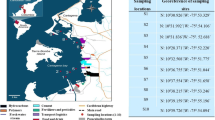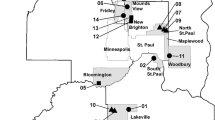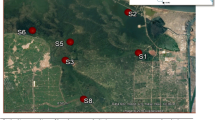Abstract
The lower Missouri River was studied to determine the distribution of selected persistent organic pollutants and bioavailable metals in depositional sediments. Nineteen sites between Omaha, Nebraska and Jefferson City, Missouri were sampled. This stretch of the river receives point-source and non-point-source inputs from industrial, urban, and agricultural activities. As part of an ecological assessment of the river, concentrations of 29 legacy organochlorine pesticides (OC pesticides), including chlordanes, DDTs, and hexachlorocyclohexanes; a select list of current-use pesticides, including trifluralin, diazinon, chlorpyrifos, and permethrin, polycyclic aromatic hydrocarbons (PAHs), polychlorinated biphenyls (PCBs), divalent metals (copper, nickel, zinc, cadmium, and lead), and polybrominated diphenyl ethers (PBDEs) were determined. Concentrations (dry weight basis) of OC pesticides in the sediments were less than 1 ng/g, with the exception of the backwater sediment collected from the mouth of the Blue River in the Kansas City metropolitan area, which contained up to 20 ng/g total chlordane, 8.1 ng/g p,p′-DDE, 1.5 ng/g lindane, 4.8 ng/g dieldrin, and 3 ng/g endrin. Concentrations of chlorpyrifos and permethrin ranged from less than 1 ng/g to 5.5 ng/g and 44 ng/g, respectively. Concentrations of PCBs ranged from less than 11 ng/g to 250 ng/g, with the Blue River and Sibley sediments containing 100 and 250 ng/g total PCBs, respectively. Concentrations of total PAHs at 17 of the 19 sites ranged from 250 to 700 ng/g, whereas the Riverfront and Blue River sites in Kansas City contained 1100 ng/g and nearly 4000 ng/g, respectively. Concentrations of the metals did not vary significantly among most sites; however, the Blue River site contained elevated concentrations of zinc (104 μg/g), cadmium (0.7 μg/g), and lead (34 μg/g) compared to the other sites. The moderately high concentrations of acid-volatile sulfide in the sediments suggest a low potential for metal toxicity to benthic organisms along this reach of the Missouri River. The depositional area sediments contained concentrations of the targeted persistent organic chemicals and metals that were below published probable effect level concentrations.







Similar content being viewed by others
References
Bolgrien DW, Andradi TR, Schweiger EW, Kelly JR (2005) Contemplating the assessment of great river ecosystems. Environ Monit Assess 103:5–20
Brumbaugh WG, May TW, Besser JM, Allert AL, Schmitt CJ (2007) Assessment of elemental concentrations in streams of the New Lead Belt in southeastern Missouri, 2002–05. US Geological Survey Scientific Investigations Report 2007–5057. US Geological Survey
De Boer J, de Boer K, Boon JP (2000) Polylbrominated biphenyls and polybrominated diphenyl ethers. In: Paasivirta J (ed) The Handbook of Environmental Chemistry, Vol. 3, Part K, New Types of Persistent Halogenated Compounds. Springer-Verlag, Berlin, pp 61–95
Galat DL, Berry CR Jr., Peters EJ, White RG (2005) Missouri River basin. In: Benke AC, Cushing CE (eds) Rivers of North America. Oxford, Elsevier, pp. 427–480
Hesse L, Sheets W (1993) The Missouri River hydrosystem. Fisheries 18(5):5–14
Hinck JE, Blazar VS, Denslow ND, et al. (2006) Biomonitoring of Environmental Status and Trends (BEST) Program: Environmental contaminants, health indicators, and reproductive biomarkers in fish from the Colorado River basin. US Geological Survey Scientific Investigations Report 2006–5163. US Geological Survey
Hinck, JE, Schmitt, CJ, Bartish, TM, et al. (2004) Biomonitoring of Environmental Status and Trends (BEST) Program: Environmental contaminants, health indicators, and reproductive biomarkers in fish from the Columbia River basin. US Geological Survey Scientific Investigations Report 2004–5154. US Geological Survey
Johnson VG, Peterson RE, Olsen KB (2005) Heavy metal transport and behavior in the lower Columbia River, USA. Environ Monit Assess 110:271–289
Keith LH (1991) Environmental sampling and analysis. Lewis Publishers, Boca Raton, FL
Krupčík J, Kočan A, Petrík J, Leclercq PA, Ballschmitter K (1993) Reference standards for quantitative trace analysis of PCB’s by GC. Technical PCB formulations for the calibration of ECD and MSD responses. Chromatographia 35:410–418
MacDonald DD, Ingersoll CG, Berger TA (2000) Development and evaluation of consensus-based sediment quality guidelines for freshwater ecosystems. Arch Environ Contam Toxicol 39:20–31
May TW, Wiedemeyer RH, Brumbaugh WG, Schmitt CJ (1997) The determination of metals in sediment pore-waters and in 1N HCl-extracted sediments by ICP-MS. Atomic Spectrosc 18:133–139
North KD, (2004) Tracking polybrominated diphenyl ether releases in a wastewater treatment plant effluent, Palo Alto, California. Environ Sci Technol 38:4484–4488
Orazio CE, Kapila S, Puri RK, Meadows JC, Yanders AF (1990) Field and laboratory studies on sources and persistence of chlordane contamination in the Missouri aquatic environment. Chemosphere 20:1581–1588
Paulson AJ, Wagner RJ, Sanzolone RF, Cox SE (2006) Concentrations of elements in sediments and selective fractions of sediments, and in natural waters in contact with sediments from Lake Roosevelt, Washington, September 2004. US Geological Survey Open-File Report, 2006–1350. US Geological Survey
Peterman PH, Orazio CE, Feltz KP (2003) Sunlight photolysis of 39 mono–hepta PBDE congeners in lipid. Organohalogen Compounds 63:357–360
Petty JD, Huckins JN, Orazio CE, et al. (1995) Determination of waterbourne bioavailable organochlorine pesticide residues in the lower Missouri River. Environ Sci Technol 29:2561–2566
Petty JD, Poulton BC, Charbonneau CS, et al. (1998) Determination of bioavailable contaminants following the flood of 1993. Environ Sci Technol 32:837–842
Poulton BC, Wildhaber ML, Charbonneau CS, Fairchild JF, Mueller BG, Schmitt CJ (2003) A longitudinal assessment of the aquatic macroinvertebrate community in the channelized lower Missouri River. Environ Monit Assess 85:23–53
Raff J, Hites R (2004) Polybrominated diphenyl ethers in Mississippi River suspended sediment. Organohalogen Compounds 66:3722–3726
Sanders M, Sivertsen S, Scott G (2002) Origin and distribution of polycyclic aromatic hydrocarbons in surficial sediments from the Savannah River. Arch Environ Contam Toxicol 43:438–448
Schmitt CJ (ed) (2002) Biomonitoring of Environmental Status and Trends (BEST) Program: Environmental contaminants and their effects on Fish in the Mississippi River Basin. US Geological Survey Biological Science Report 2002–0004. US Geological Survey
Schweiger EW, Bolgrien DW, Andradi TR, Kelly JR (2005) Environmental monitoring and assessment of a great river ecosystem: the upper Missouri River pilot. Environ Monit Assess 103:21–40
Song W, Ford JC, Li A, et al. (2005) Polybrominated diphenyl ethers in the sediments of the Great Lakes. 3. Lakes Ontario and Erie. Environ Sci Technol 39:5600–5605
Sparks RE (1995) Need for ecosystem management of large rivers and their floodplains. Bioscience 45:168–182
US EPA (US Environmental Protection Agency) (2005) Procedures for the derivation of equilibrium partitioning sediment benchmarks (ESBs) for the protection of benthic organisms: metal mixtures (cadmium, copper, lead, nickel, silver, and zinc). EPA-600-R-02–011. US EPA, Washington, DC
US EPA (US Environmental Protection Agency) (2007) Hudson River PCBs Superfund Site. http://www.epa.gov/hudson/sed_sampling_fs10_03.pdf (accessed August 2007)
US Geological Survey (2007) Upper Midwest Environmental Sciences Center, Sediment-Contaminant Database. http://www.umesc.usgs.gov/data_library/sediment_contaminants/sediment_contaminant_page.html (accessed May 2007)
Wilkison D, Armstrong D, Norman R, Poulton B, Furlong E, Zaugg S (2006) Water Quality in the Blue River basin, Kansas City metropolitan area, Missouri and Kansas, July 1998 to October 2004. US Geological Survey Scientific Investigations Report 2006–5147. US Geological Survey
Yunker MB, Macdonald RW, Vingarzan R, Mitchell RH, Goyette D, Sylvestre S (2002) PAHs in the Fraser River basin: a critical appraisal of PAH ratios as indicators of PAH source and composition. Organ Geochem 33:489–515
Acknowledgments
Several individuals applied their expertise to this project. The authors appreciate their contribution to this effort—trace organic analysis: M. Tanner, J. Meadows, G. Tegerdine, K. Feltz, and R. Gale; trace metals analyses—M. Walther, J. Arms, and S. Olson for carbon analysis. Also, thanks to those who collected the sediments: D. Gullic, R. Niemeyer, B. Nodine, and C. Wakefield. This work was funded through US EPA and Missouri Department of Natural Resources. Thanks to J. Besser and L. Cleveland for their comments on an earlier version of the manuscript.
Author information
Authors and Affiliations
Corresponding author
Rights and permissions
About this article
Cite this article
Echols, K.R., Brumbaugh, W.G., Orazio, C.E. et al. Distribution of Pesticides, PAHs, PCBs, and Bioavailable Metals in Depositional Sediments of the Lower Missouri River, USA. Arch Environ Contam Toxicol 55, 161–172 (2008). https://doi.org/10.1007/s00244-007-9123-0
Received:
Accepted:
Published:
Issue Date:
DOI: https://doi.org/10.1007/s00244-007-9123-0




